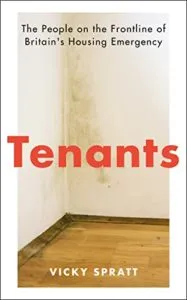Tenants – knowing what’s wrong shows us how to fix it
Published: by Alastair Harper

I read Tenants, Vicky Spratt’s important new book on the housing emergency, on a slow train-ride from Cornwall, my journey carving through coastal towns and villages very much on the front line of the housing emergency. Cornwall has seen its housing waiting list almost double since 2019, from 12,000 to 22,000 households. At the same time, we as a country are losing around 20,000 social homes every year.
In the South West, the matching of the housing market to the global tourism industry, rather than local incomes, has proved disastrous for residents. Cornwall Council’s permitting developers to build so-called ‘affordable rent’ homes, instead of homes at a genuinely affordable social rent, has worsened matters. Social rent in Cornwall averages £87, while affordable rent is £122; a crucial £35 a week that could make all the difference for those now struggling with food and fuel bills.
Tenants investigates how this disastrous situation has been allowed to come about in the UK. Spratt, who has covered the housing emergency for years as a leading journalist, blends an overview of political failure with the personal experiences of those going through eviction, facing unfair charges or being exploited by their landlords.
How have successive governments been allowed to preside over a housing system that serves so few of us and puts so many at risk of homelessness? Reading this book, it seemed to me that one reason is government’s persistent refusal to ‘see’ the problem, and acknowledge that the private rented sector has doubled. Or that tenants within this sector all face the risk of ‘no fault’ eviction.
Eyes remain closed to the loss of 20,000 social homes a year, or the ways in which we’ve made our most needed tenure the hardest to deliver. Sure, those stats are out there, but government doesn’t really see them, because it remains focused on one thing – a big number for overall housing delivery which has come at the cost of all else.

A book that pairs well with Tenants is Seeing Like A State by James C. Scott, which looks at how bad or brutal planning decisions have been made by different forms of government. In Seeing Like a State, Scott lays out the compelling theory that in order to govern in complex and nuanced areas and issues, governments need to simplify what they are looking at, just as the tube map simplifies the London Underground.
In doing so, they remove extraneous information to focus more clearly on the important factor – GDP, population number, etc – and this simpler view makes for clearer decisions. But if they remove information they didn’t realise was actually also crucial, they risk making horrifically bad decisions. This kind of oversimplification can lead to crop failure, famine, broken cities. Tenants, meanwhile, shows how this has happened to our nation’s housing policy.
Recently, there has been some controversy over the Conservative manifesto commitment to deliver 300,000 new homes a year. Michael Gove has said he would try his best to deliver the target – provoking speculation that its delivery was being deprioritised. But anyone shocked by the story told in Tenants can only hope this is true, because prioritising a big overall delivery of supply has come at the expense of the specific housing types we needed most.
It was focusing solely on overall supply that led to deeply harmful government policies like Help to Buy. As Tenants powerfully argues, ‘people who bought [Help to Buy] homes were people who would probably have been able to buy a house without the scheme’. It was only accessible to people who earned far more than the average, and yet it cost the taxpayer billions. Why on earth was it pursued?
A target pursued in a context-free vacuum leads to policies designed to only deliver that target, with no focus on the paralysing problems so many people face: unfair renting rules and a lack of genuinely affordable social homes. Instead, the tyranny of the target meant encouraging developers to build the homes that were cheapest to construct and netted them the most money.
Schemes like Help to Buy, First Homes and Shared Ownership all came off the conveyor belt under a different Secretary of State. Each with a different logo, all making housing more expensive and developers richer, and all because government was preoccupied solely with that target of 300,000. (This is a mistake the Labour party have recently been making too, actually criticising the government for not focusing enough on those developer-subsiding policies and receiving criticism for how they understood the housing numbers. Clearly, missing the real housing emergency is not a partisan issue.)
Still, Tenants does conclude its comprehensive account with a note of cautious optimism. Referring to the fresh approach taken by the current Secretary of State Michael Gove and his remarks on delivering a new era of social housing, Sprat says ‘it felt, finally, as if the Conservatives understood the problem’. But the book rightly goes on to warn that ‘drawing the same conclusions as housing experts and committing to their proposed solutions are not one and the same.’
Since the publication of Tenants, we have seen a bit more detail on the possibility of that commitment. We have a consultation on Compulsory Purchase Orders that could bring an end to how old land rules prevent the building of social housing, a new white paper on rebalancing and reforming the rights of renters, and new legislation going through Parliament to help social housing tenants more easily fix problems in their homes. It’s possible that Spratt’s cautious optimism will not prove unfounded, but we certainly won’t be stepping down the pressure.